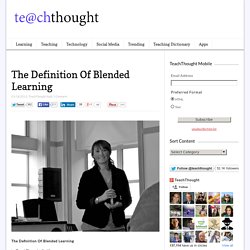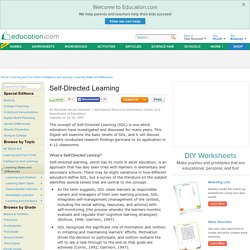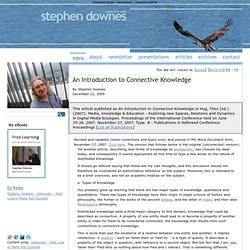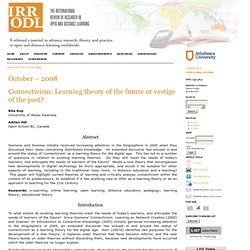

The Definition Of Blended Learning. The Definition Of Blended Learning by TeachThought Staff Blended education.

Hybrid learning. Flipping the classroom. 5 reasons why blended learning works. Why Blended Learning Is Better. Blended learning is a buzz word that’s been thrown around quite a bit lately and brings together the best of both classroom learning and elearning.

In fact it seems to be the ideal solution all-around as it appeals to all learning styles, circumstances, needs and demands. It combines the support of classroom learning with the flexibility of elearning. Blended learning has been defined by Innosight Institute as “a formal education program in which a student learns at least in part through online delivery of content and instruction with some element of student control over time, place, path or pace.” Self-Directed Learning. The concept of Self-Directed Learning (SDL) is one which educators have investigated and discussed for many years.

This Digest will examine the basic tenets of SDL, and it will discuss recently conducted research findings germane to its application in K-12 classrooms. What is Self-Directed Lerning? Self-directed learning, which has its roots in adult education, is an approach that has also been tried with learners in elementary and secondary schools. There may be slight variations in how different educators define SDL, but a survey of the literature on the subject identifies several tenets that are central to the concept.
Online learning insights. The Web as a classroom is transforming how people learn, is driving the need for new pedagogy; two recently launched courses at Coursera highlight what happens when pedagogical methods fail to adapt.

Divided pedagogy I wrote recently about the Fundamentals of Online: Education [FOE] the Coursera course that was suspended after its first week and is now in MOOC hibernation mode. Over thirty thousands students signed up for the course hoping to learn how to develop an online course. It was a technical malfunction when students were directed to sign-up for groups through a Google Doc that shuttered the course, along with hundreds of student complaints about lack of clear instructions, and poor lecture quality. The course was suspended on February 2, and there has been no word yet as to when it will resume :(. The Tale of the Two What made e-Learning and Digital Cultures successful and FOE not? Our current higher education system is grounded in behaviorist and cognitive theories. References. Comm Theory Persuassion - 4985 Dainton Chapter 5.
Locus of Control. Explanations > Preferences > Locus of Control Internal | External | So what?

Locus of Control as a principle was originated by Julian Rotter in 1954. It considers the tendency of people to believe that control resides internally within them, or externally, with others or the situation. Note that, like other preferences, this is a spectrum. Some people have a wholly internal or external locus of control, but many will have some balance both views, perhaps varying with situation. Internal People with a high internal locus of control believe in their own ability to control themselves and influence the world around them. Rotter (1990) describes the internal locus of control as: 'the degree to which persons expect that a reinforcement or an outcome of their behavior is contingent on their own behavior or personal characteristics' They are more likely to have expectancy shifts, where a sequence of similar events are expected to have different outcomes.
External Stability See also Blame vs. ~ Stephen's Web. Revised and Updated (minor corrections and typos only) and placed in MS-Word Document form, November 27, 2007.

Click here. The version that follows below is the original (uncorrected) version). Yet another article, describing new forms of knowledge as probablistic, has crossed my desk today, and consequently it seems appropriate at this time to type a few words on the nature of distributed knowledge. It should go without saying that these are my own thoughts, and this discussion should not therefore be considered an authoritative reference on the subject. Moreover, this is intended to be a brief overview, and not an academic treatise on the subject. a.
The Connectivist Learning Environment. Connectivism: Learning theory of the future or vestige of the past? Welcome to CCK11 ~ CCK11. Conectivismo. Connectivism: Learning theory of the future or vestige of the past? Rita KopUniversity of Wales Swansea Adrian HillOpen School BC, Canada Abstract Siemens and Downes initially received increasing attention in the blogosphere in 2005 when they discussed their ideas concerning distributed knowledge.

Daphne Koller: What we're learning from online education. CoP: Best Practices. By Etienne Wenger [Published in the "Systems Thinker," June 1998] You are a claims processor working for a large insurance company.

You are good at what you do, but although you know where your paycheck comes from, the corporation mainly remains an abstraction for you. The group you actually work for is a relatively small community of people who share your working conditions. It is with this group that you learn the intricacies of your job, explore the meaning of your work, construct an image of the company, and develop a sense of yourself as a worker. You are an engineer working on two projects within your business unit. You are a CEO and, of course, you are responsible for the company as a whole. eLearning article by George Siemens. Connectivism.